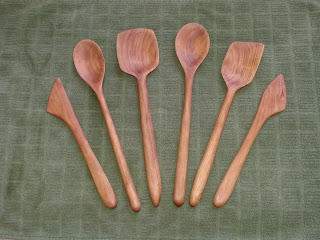I have a friend from worker who does ceramics on the side. She does nice work, so I asked her to make me a set of 10 drinking cups. She asked for cherry spoons. Here are the spoons. I will post pictures of the great cups she made when my camera cooperates.
This is the first time I have worked with cherry wood. It is awfully pretty, but not quite as strong or predictable as maple. The grain is more predictable in maple than in cherry. The maple is harder, too, so the cherry was a lot easier to carve.
Sunday, June 16, 2013
Subscribe to:
Post Comments (Atom)


4 comments:
Those turned out really nice. Really really nice. I'm hoping she actually uses them, because I would be tempted to just stare at them.
I hope she uses them, too. I made her a spoon out of maple in January or so. I asked her last month how it was holding up (it was a new design) and she said she didn't know because it was too pretty to use. That was not the kind of design feedback that I find helpful.
I have often wondered about pitting and knots in spoons and the like. Does a knot found in the material like the spreader on the right, which obviously cannot sand out, catch food particles that become difficult to remove when cleaning the utensil? Do you have to worry about food borne illness from that potentiality? They say to get rid of plastic food storage bins when they become pitted from boiled oils in the microwave for that reason...
Cami and Jer:
That is a good question, and it just depends on the knot. If the knot is solid, with no hole, then there shouldn't be a problem. But even if there is a small crack, then you can deal with it. The big thing with wooden utensils is to clean them soon after using them. So, stuff that we can let slide with plastic, like letting them sit overnight or letting them soak in filthy dishwater, don't work with wood.
That being said, the dark spot on that spreader shouldn't be a problem. It wasn't a knot - just a spot where the grain went funny and some sap lived.
Post a Comment